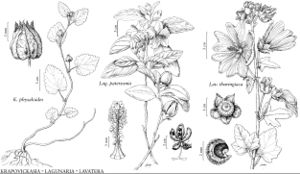Lavatera
Sp. Pl. 2: 690. 1753.
Gen. Pl. ed. 5, 308. 1754.
| Taxon | Illustrator ⠉ | |
|---|---|---|
 | Krapovickasia physaloides Lagunaria patersonia Lavatera thuringiaca | Linny Heagy Linny Heagy Linny Heagy |
Herbs, subshrubs, or shrubs, perennial or annual [biennial], stellate-hairy or glabrate. Stems erect. Leaves: stipules early-deciduous, narrowly triangular, lanceolate, oblanceolate, or linear; blade lanceolate or ovate to orbiculate, narrower above, base rounded to wide-cuneate, unlobed or palmately 3–7-lobed, margins crenate or dentate or nearly entire. Inflorescences axillary solitary flowers, [fascicles], or terminal racemes; involucel present, bractlets persistent, 3, connate ca. 1/2 toward base, cupuliform. Flowers: calyx not accrescent, not inflated, lobed triangular to ovate, not ribbed; corolla broadly trumpet-shaped to nearly rotate, rose-pink, white, or purple, usually with darker purplish veins; staminal column included; ovary [9–] 12–22 [–40] -carpellate; ovules 1 per cell; style [9–] 12–22 [–40] -branched (same number as locules); stigmas introrsely decurrent, filiform. Fruits schizocarps, erect, not inflated, flattened-globose, discoid, somewhat indurate, persistent style base swollen, conic or disc-shaped; mericarps [9–] 12–22 [–40], drying tan or brown, 1-celled, elliptic in cross-section, edges rounded, walls readily separating from seed, without dorsal spur, not beaked, sometimes slightly ridged or keeled, apex rounded, glabrous or hairy, indehiscent. Seeds 1 per mericarp, glabrous. x = 14.
Distribution
Introduced; s Europe (Mediterranean regions), sw Asia (to Kashmir), Africa (Ethiopia), Atlantic Islands (Canary Islands), also widely
Discussion
Lavatera has traditionally been distinguished from Malva by its cuplike, basally fused involucellar bractlets. Based on molecular evidence, Lavatera and Malva are nearly indistinguishable, and while still accepted here based upon different criteria, Lavatera taxa eventually may be combined with Malva. Lavatera arborea Linnaeus, L. assurgentiflora Kellogg, and L. cretica Linnaeus of previous treatments have been transferred to Malva, and some epithet changes were necessary.
Lavatera cachemiriana Cambessèdes is commonly cultivated and may escape; it is similar to L. thuringiaca but has denser, long-stellate indument and the involucellar bractlets are two-thirds as long as the calyx, are broadly ovate with acute apices, fused at base into a cup about 1 cm long, barely appressed to the calyx, and are accrescent in fruit.
Species ca. 12–25 (3 in the flora).
Selected References
Lower Taxa
Key
| 1 | Annual herbs, 0.5–1.4 m; petals rose-pink or white, bases usually overlapping and obscuring calyx surface. | Lavatera trimestris |
| 1 | Perennial herbs or subshrubs, or shrubs, usually 1–2 m; petals pale purplish pink or darker purple-violet, bases not overlapping, calyx surface clearly visible between | > 2 |
| 2 | Subshrubs or shrubs; stems ± woody at base; inflorescences solitary flowers, sometimes racemelike, subsessile, pedicels 0.2–0.7 cm; plants usually hispid throughout. | Lavatera olbia |
| 2 | Herbs; inflorescences solitary flowers, sometimes racemelike but not congested, pedicellate, pedicels 2–5 cm; plants usually puberulent to tomentose throughout. | Lavatera thuringiaca |
"narrower" is not a number.